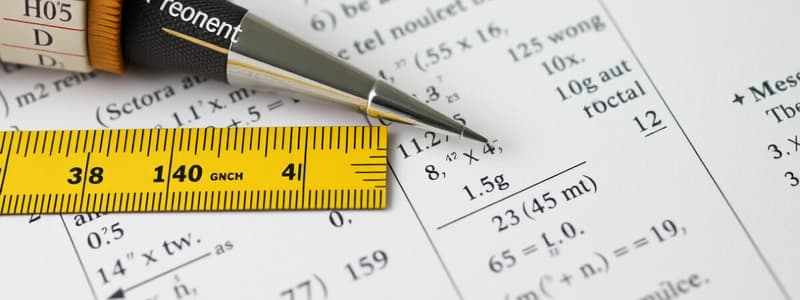Podcast
Questions and Answers
What is the definition of accuracy?
What is the definition of accuracy?
- The possible y values or output
- A description of how close a measurement is to the true value of the quantity measured (correct)
- Exactness of a measurement
- The exact number of significant figures in a measurement
What does precision refer to?
What does precision refer to?
- The amount of significant figures in a number
- The relationship between input and output values
- The exactness of a measurement (correct)
- The set of possible x values
What are significant figures?
What are significant figures?
The amount of significant figures in a number that can be found by counting.
What is a relation in mathematics?
What is a relation in mathematics?
What defines a function?
What defines a function?
What does range refer to?
What does range refer to?
What does domain refer to?
What does domain refer to?
Any number (except 0) with an exponent of 0 equals ______.
Any number (except 0) with an exponent of 0 equals ______.
What is the Negative Exponent Property?
What is the Negative Exponent Property?
What is the Product of Powers Property?
What is the Product of Powers Property?
What is the Quotient of Powers Property?
What is the Quotient of Powers Property?
What is the Power of a Product Property?
What is the Power of a Product Property?
What is the Power of a Quotient Property?
What is the Power of a Quotient Property?
What is the Power of a Power Property?
What is the Power of a Power Property?
What are rational exponents?
What are rational exponents?
What are unequal bases?
What are unequal bases?
What are real numbers?
What are real numbers?
What are irrational numbers?
What are irrational numbers?
What are rational numbers?
What are rational numbers?
What are integers?
What are integers?
What are whole numbers?
What are whole numbers?
What are natural numbers?
What are natural numbers?
What does PEMDAS stand for?
What does PEMDAS stand for?
What are coefficients?
What are coefficients?
What are factors?
What are factors?
Flashcards are hidden until you start studying
Study Notes
Measurement Terminology
- Accuracy refers to how close a measurement is to the true value of a quantity.
- Precision indicates the exactness of a measurement.
- Significant Figures are the digits in a number that contribute to its precision, determined by counting.
Mathematical Relationships
- Relation describes associations between input (x) and output (y) values.
- Function specifies a special type of relation where each input value corresponds to only one output value.
Key Concepts in Functions
- Domain represents all possible input (x) values.
- Range consists of all possible output (y) values.
Exponent Properties
- Zero Exponent Property states that any non-zero number raised to the power of zero equals one.
- Negative Exponent Property indicates that any number raised to a negative power is equivalent to the reciprocal of the number raised to the positive exponent.
- Product of Powers Property requires adding exponents when multiplying two powers with the same base.
- Quotient of Powers Property involves subtracting exponents when dividing powers with the same base.
- Power of a Product Property entails finding the power of each factor in a product and multiplying the results.
- Power of a Quotient Property requires applying the power to both the numerator and denominator, canceling any common factors.
- Power of a Power Property involves multiplying the exponents when raising a power to another power.
- Rational Exponent Property shows that fractional powers can be converted to radical expressions, where the numerator is the exponent and the denominator is the index of the radical.
Types of Numbers
- Real Numbers include all rational and irrational numbers; they encompass every non-imaginary number.
- Irrational Numbers cannot be expressed as a simple fraction, featuring non-repeating, non-terminating decimals.
- Rational Numbers are represented as fractions, including terminating or repeating decimals.
- Integers encompass positive and negative whole numbers, including zero, excluding fractions and decimals.
- Whole Numbers include all positive integers as well as zero but exclude negative values.
- Natural Numbers consist solely of positive integers, excluding zero.
Order of Operations
- PEMDAS is a mnemonic for the order of operations:
- Parentheses
- Exponents
- Multiplication and Division (left to right)
- Addition and Subtraction (left to right)
Algebraic Components
- Coefficients are the numbers that precede variables, indicating how many times the variable is included in the expression.
- Factors are values that can be multiplied together to yield a product.
Studying That Suits You
Use AI to generate personalized quizzes and flashcards to suit your learning preferences.




